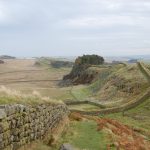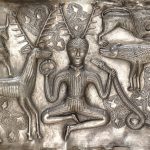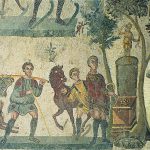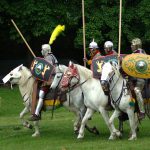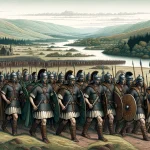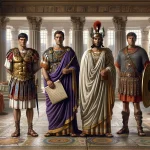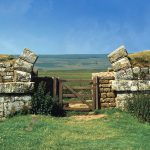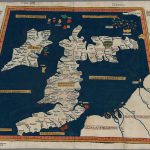Old Penrith (Voreda) Roman Fort
Flavian Auxiliary Fort (AD 69–96), Marching or Temporary Camp and Vicus
The earthwork remains of Voreda Roman fort at Old Penrith. It was occupied from the 1st to 4th century AD. The vicus appears to have been abandoned in circa 300 AD. A well, steelyard, a complete quern, and coins were found.
Who Built the Old Penrith (Voreda) Roman Fort?
RIB 940 - Dedication to the Divinities of the Emperors
To the Divinities of the Emperors the detachment of the Twentieth Legion Valeria Victrix, ..
[... ]X [...] VIC
[...]
No commentary.
The building inscription above shows that the fort at Old Penrith was originally built by a ‘vexillation’ of legionaries from the Twentieth Legion, who were stationed in Britain for the entire period of Roman rule, for much of this time in the legionary fortress at DEVA (Chester, Cheshire).
RIB 929 - Fragmentary dedication-slab by Second Cohort of Gauls
… for the Second Cohort of Gauls, Severiana Alexandriana, … enlarged … under Calvisius Rufus, emperor’s propraetorian legate, under the charge of Aurelius ..
II GAL ⟦[...] A⟧ AMÍ¡PL[...]
SVB · CALVISIO · RV[...]
CVRANTáE · AVREÍ¡LI[ ...]
Calvisius Rufus seems to be one of the governors of Britannia Inferior between 225 and 235 (Birley in Askew, Coinage 82).
A certain amount of rebuilding was undertaken by the auxiliary garrison during the early third century, evidenced by several datable inscriptions claiming responsibility for renovation work, especially of the shrines to the gods (RIB 929 et al., infra). Prof. St. Joseph observed the fort from the air shortly after the Second World War and noted the outline of the principia in the centre of the fort with the commanding officer’s house, the praetorium, to the west and two granaries (horrea) on the east.
Who Garrisoned the Old Penrith (Voreda) Roman Fort?
Cohors Secundae Gallorum [Equitata] – The Second Cohort of Gauls, part-mounted
RIB 917 - Altar dedicated to Jupiter Optimus Maximus
To Jupiter, Best and Greatest, for the Second Cohort of Gauls, part-mounted, Titus Domitius Hieron, from Nicomedia, its prefect, (set this up).
COH
II GAL EQ
T DOM[...]TI
VS H[...]ERON
D NICOMEDIA
PRAEF
Nicomedia, in Bithynia.2. For the use of the dative of advantage to express the unit on a building-dedication see RIB 1463 (Chesters).Domitius Hieron is mentioned on a military diploma of 23 March 178 from Bulgaria (Roxan and Holder, RMD IV, 293).
The Second Cohort of Gauls were a part-mounted unit levied from the various Gallic tribes of central and northern France, and are mentioned on four inscriptions on stone recovered from Voreda. Three of the stones can be dated and prove that this unit were stationed at the fort from at least 178AD (vide RIB 917 supra) to c.249AD (see RIB 915 below).
RIB 915 - Altar dedicated to Jupiter Optimus Maximus
To Jupiter, Best and Greatest, and to the Genius of our Lord-Emperors the Philippi Augusti the Second Cohort of Gauls ..
ET G DD
NN PHI
LIPPORV[...]
AVGG COH
[...] GALLO[...]
[...]
No commentary.
Five military diplomas naming this unit in Britain are variously dated from 122AD (CIL xvi.69) until 178AD (RMD 184; vide RIB 917 supra). It would appear that Cohors II Gallorum came to Britain in the train of the emperor Hadrian, and were removed following the dissolution of the Gallic Empire in 274AD – evidently due to their pro-Gallic views – during which entire period they were garrisoned at the Voreda fort.
The unit is not recorded anywhere else in Britain but an undated altarstone has been found at Piacenza in Italy, which appears to have been transported back from Voreda by the prefect Lucius Naevius Verus Roscianus, presumably after he had retired from military service because he wished to be reminded of his old unit, also likely because the stone had cost him a lot of money.
RIB 920 - Altar dedicated to the Mother Goddesses from overseas
To the Mother Goddesses from overseas the detachment of Germans of Voreda for the welfare of … willingly and deservedly fulfilled their vow.
TRIBVS TRAMARI
VEX GERMA[...]R V[...]R[...]D PRO SA
LVTE R [.] F V S L M
Its origin is uncertain; Horsley thought it came from Brougham; Haverfield conjectured that it might have come from Old Penrith and suggested that l. 4 might be a corrupt reading of the place-name Voreda; Birley inclines to assign it to Brougham.
The Roman Gods of Old Penrith
RIB 922 - Altar dedicated to Moguns
To the god Moguns for the welfare … willingly and deservedly fulfilled his vow.
MOVNTI
[...]RO SALVE
[...] STI V S
L M
For di Mountes see RIB 1269 (High Rochester).
RIB 923 - Dedication to Silvanus
To the god Silvanus (…) gladly set up his vow.
VOTVM LET
[...]OSVV[...]
Haverfield (Cumb. Westm. AAST 1st Ser. xv (1899) 464) suggests that this might be identical with RIB 763, but Machell’s drawing of that altar disproves this.
Shrines Repaired in the Third Century
RIB 916 - Altar dedicated to Jupiter Optimus Maximus of Doliche
In honour of the Divine House, to Jupiter, Best and Greatest, of Doliche, Aurelius Attianus (?), prefect of the Second Cohort of Gauls, restored this temple fallen in through age.
VETVSTATE CO[...]
AVREL[...]VS AT[...]
[... ]OH II [... ...]
1. The word used for the building is missing: it was presumably aedem or templum, with the past participle conlaps… in agreement.
RIB 919 - Dedication to the Mother Goddesses from overseas and to the Divinity of the Emperor
To the Mother Goddesses from overseas and to the Divinity of the Emperor Alexander Augustus and to Julia Mammea, mother of our Emperor and of the army, and to their whole Divine House, the detachment of Marsacians [restored] this ruined shrine ..
ET N IMP ALEXANDRI AVG ET IVL MAM
MEAE MATR AVG N ET CASTRORVM TO
[...] DOMVI DIVINE AE
[... ...]LATIO M[...]R
[...]
- The emperor Alexander Severus (Imp. 13 March 222AD – March 235) and his mother, the last of the Syrian princess matriarchs.
- Based of the dubious expansion M[ilites] R[omanorum]; the rest of the inscription is lost, but we can guess that they claim responsibility for restoration work.
- The Marsaci, or Marsacii, were a German tribe living in Zeeland at the mouth of the Rhine
- Subsequent lines will have given the agents of the work and the names of the consuls.
Vicani Voredensium
The civilian settlement or vicus at Old Penrith was observed from the air shortly after the Second World War by Prof. J.K. St. Joseph, when it was seen to extend both to the north of the fort and on the slopes to the west (JRS 1951 p.54).
Other Roman Civilian Tombstones from Old Penrith
- A carving on this tombstone possibly depicts the winner of a chariot race holding a whip and a palm branch; perhaps the boy was indulged in his childhood dream of becoming an auriga, a professional charioteer.
- The testator may equally have been a brother; I have made him their cousin purely because of the dissimilarity in names.
Other Roman Sites in the Neighbourhood
Temporary Marching Camps
There are two marching camps lying close by the Voreda fort to the north-north-west, at Galley Gill (NY4938) only about ¼mile (500m) away, and at Knowe Farm (NY4839) almost ½mile (800m) distant. There is another irregularly-shaped camp lying close beside the road at Plumpton Head (NY5035) two miles (3.1km) to the south.
RIB 2287 - Milestone of Victorinus
The Emperor Caesar Marcus Piavonius Victorinus Pius Felix [..
M PIA[...]O
NIVS VIC
TORINVS
PIVS FE[ ...]
As Nicolson (MS. Ashmole 1816 f. 515) says ‘digg’d up … in the side of ye Roman Way, near Camden’s Petriana‘, it appears that the stone was found outside the fort. In contrast Nicolson to Dr. Smith, 7 Apr. 1701 (Nicolson, W., Bodl. MS. Eng. Hist. b. 2 f. 235v), says ‘found … amongst the ruins … of Petriana‘. Presumably this entry led Haverfield to say (Cumb. Westm. AAST 2nd Ser. xiii (1913) 193) that it was found inside the fort and might be an honorific inscription. Ross (Cumb. Westm. AAST 2nd Ser. 18 (1918) 220), in calculating mileage, estimates that this had stood at the central gateway on the east side of the fort (see also Birley, Cumb. Westm. AAST 2nd Ser. 47 (1947) 177) R.P.W.Victorinus, A.D. 268-70.
A Roman milestone found about ½mile north of Voreda (NY4938) was inscribed IMP CAES M PIAVONIVS VICTORINVS PIVS FEL… “Imperator Caesar Marcus Piavonius Victorinus Pius Felix [Invictus Augustus]” (RIB 2287). Victorinus became the emperor of the break-away Gallic Empire in the summer or autumn of 269AD, following the death – by strangulation – of Postumus’ successor Marius after he had been in office for only a few months. Victorinus himself was only to last until the spring of 271AD, before being killed for propositioning the wife of one of his own generals.
RIB 930 - Inscription
Born for the good of the state.
REI
PVBLICAE
NATO
This formula was sometimes applied to emperors in the fourth and fifth centuries.
Classical References for Voreda
The Antonine Itinerary lists the Old Carlisle fort near the beginning of Iter II where the name appears as Voreda, lying 14 miles from (Carlisle, Cumbria) and 13 miles from Bravoniacvm (Kirby Thore, Cumbria). The [link_post post_id="1497" type="link"]Ravenna Cosmology (R&C#128) cites the name Bereda, between the entries for Verteris (Brough, Cumbria) and Carlisle (Luguvalium) Roman Fort. The name of the fort is confirmed on an important inscription recovered from Old Penrith (vide RIB 920 infra) where the name appears Voreda.
References for Voreda
- Chronicle of the Roman Emperors by Chris Scarre (Thames & Hudson, London, 1995);
- Chronology of the Ancient World by E.J. Bickerman (Thames & Hudson, London, 1980);
- The Roman Inscriptions of Britain by R.G. Collingwood and R.P. Wright (Oxford 1965);
- Air Reconnaissance of North Britain by J.K. St. Joseph in J.R.S. xli (1951) p.52-65;
Roman Roads near Voreda
NNW (6) to Barrockside Itinera II et V: SSE (7) to Brocavvm SSE (2.5) to Plvmpton Head S (2) to Salkeld Gate S (3) to Stonybeck SW (10) to Trovtbeck (Cumbria) Iter II: NNW (8) to Wreay (Cummersdale, Cumbria)
Sites near Old Penrith (Voreda) Roman Fort
- Galley Gill Temporary Camp (1 km)
Marching or Temporary Camp - Knowe Farm (Old Penrith 3) (1 km)
Marching or Temporary Camp - Salkeld Gate Fortlet (2 km)
Fortlet - Marching Camp Plumpton Head (3 km)
Marching or Temporary Camp - Barrock Fell Roman Signal Station (9 km)
Signal Station - Barrockside Camp (10 km)
Marching or Temporary Camp - Langwathby Moor Temporary Camp (10 km)
Marching or Temporary Camp - Brougham Camp (10 km)
Marching or Temporary Camp - Brougham (Brocavum) Roman Fort (11 km)
Flavian Auxiliary Fort (AD 69–96) and Vicus - Wreay Hall Signal-Station (11 km)
Signal Station
